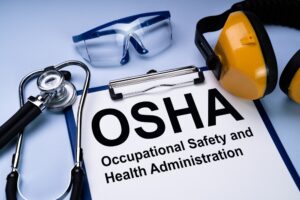The Occupational Safety and Health Administration (OSHA) continues to carry out inspections and issue citations to employers that expose workers to hazardous conditions. We’ve summarized some of the key enforcement cases from the past few months for a look at where OSHA is focusing its efforts.
Food processor supplier fined $1.7 million
An Ohio-based food processor supplier entered into a settlement agreement with OSHA to resolve citations issued to the company following investigations into the cause of injuries suffered by two temporary workers at the plant. OSHA inspectors determined the company exposed workers to hazards by allowing machinery to operate without required safety guards during production and didn’t de-energize equipment during sanitation operations. In addition to the monetary penalties, the company has agreed to make multiple safety improvements at its facility, including enhancing machine guarding, developing lockout/tagout procedures, and training employees on the new safety procedures.
Penalty: $1,700,000
Repeat hazards lead to seven-figure fine
OSHA cited a general contractor in Guam with nine willful violations for its multiple failures to protect employees working in trenches. Federal investigators found that the company, which has a history of failing to protect employees working in trenches from potentially deadly harm, had employees working in trenches deeper than 5 feet without required safety equipment. Since 2014, the company has been subject to five other OSHA inspections in which the agency cited the company for nine violations, including two serious violations and one repeat violation in October 2022.
Penalty: $1,038,918
Auto recycler cited for three dozen violations
A national auto recycler and used part supplier chain entered into a settlement agreement with OSHA to resolve 35 citations issued for workplace safety violations at one of its facilities in New York. OSHA issued two willful violations for failing to ensure employees could exit the workplace safely and four repeat violations for not protecting workers from machine operation hazards, inadequate machine lockout/tagout procedures, and failure to control flammable liquids. Investigators also found insufficient protection from fall, electrical, and noise hazards. As part of the settlement agreement, the company must implement a comprehensive corporate safety and health management system that includes the following:
- Multiple safety audits of the facility by a third-party consultant;
- Safety training programs based on the audit findings; and
- Multiple avenues for workers to participate in safety efforts without fear of retaliation, including a safety management committee that will review audit findings and evaluate the progress of the company’s safety programs.
Penalty: $868,628
Fall hazards lead to fines
A New Jersey-based construction contractor was again cited for exposing employees to potentially deadly fall hazards in eight worksite inspections from November 2023 to March 2024. In the eight inspections, OSHA investigators identified 32 safety violations. In each inspection, the agency found the company failed to provide workers with required fall safety protection. In addition, investigators cited the company for the following:
- Allowing employees to use portable ladders unsafely,
- Exposing employees to silica hazards and failing to train workers to recognize them,
- Allowing the operation of machines without required guards,
- Failing to have hazard communication or written exposure control programs, and
- Not providing employees with eye and face protection.
Penalty: $819,417
Food manufacturer cited for safety violations
OSHA cited a large food manufacturer that has a history of hazardous workplace safety practices for dozens of safety and health violations at one of its facilities in Pennsylvania. In October 2023, OSHA inspectors opened an investigation in response to a complaint alleging hazards involving the company’s handling of highly hazardous chemicals. OSHA cited the company for 70 violations, including nine repeat, 51 serious, and 11 other-than-serious violations. The infractions related to numerous process safety management (PSM) failures, such as a lack of training, not correcting equipment deficiencies, failing to document that equipment complied with recognized and generally accepted good engineering practices, and failing to establish an emergency plan for the entire plant.
Penalty: $761,876
Ammonia exposure leads to fines
A pork processing facility in Ohio was issued 43 violations following two inspections opened after two workers suffered exposure to ammonia gas during maintenance of a refrigeration system. OSHA issued 40 serious violations, two other-than-serious violations, and one repeat violation. The company received the repeat violation for exposing employees to amputation and other serious hazards due to inadequate point-of-operation guarding on a meat saw. OSHA cited the company with serious violations that included:
- Lack of fall protection,
- Inadequate permit-required confined space procedures,
- Inadequate lockout/tagout procedures for machines,
- Electrical safety-related work practices,
- Unsafe electrical equipment and installations,
- Lack of personal protective equipment,
- Noise exposure,
- Lack of an emergency eyewash/shower,
- No hazard communication plans,
- Failure to mark all exits,
- Lack of lockout devices, and
- Unsafe walking-working surfaces and stairways.
Penalty: $528,441
Repeat fall protection violations lead to citations
OSHA cited a window cleaning company in Massachusetts with two willful, four serious, and two repeat violations for failure to inspect and replace damaged or defective equipment that contributed to an employee’s fatal 29-story fall from a building in downtown Boston’s financial district in October 2023. OSHA’s investigation also determined that the company:
- Failed to adequately train employees on how to inspect ropes for maximum allowable wear and recognize defects and conditions that warrant removal from service, as well as train employees on proper use of the rope descent system;
- Allowed the use of rope descent system ropes, lifelines, and lanyards for personal fall protection that weren’t compatible with connectors and unprotected from damage such as cuts and erosion; and
- Failed to use only certified building anchorage for the rope descent system.
Penalty: $447,087

